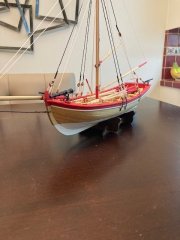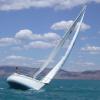
DaveF
Members-
Posts
33 -
Joined
-
Last visited
Recent Profile Visitors
-
 donfarr reacted to a post in a topic:
Nautical and Model Building Resources
donfarr reacted to a post in a topic:
Nautical and Model Building Resources
-
 paulsutcliffe reacted to a post in a topic:
dentist binocular loupe
paulsutcliffe reacted to a post in a topic:
dentist binocular loupe
-
 butch reacted to a post in a topic:
Staining wood
butch reacted to a post in a topic:
Staining wood
-
 Starboard III reacted to a post in a topic:
Researching a Constitution Build
Starboard III reacted to a post in a topic:
Researching a Constitution Build
-
 GLakie reacted to a post in a topic:
Researching a Constitution Build
GLakie reacted to a post in a topic:
Researching a Constitution Build
-
Hi Fletch: He's not on this site but MSB. His name is Cadman there and he is drawing the Constitution to those specs. I know he has done a lot of research into it and been in touch with the curators etc at the museum. Maybe he can help Look under plans section I think. Dave
-
 trippwj reacted to a post in a topic:
Nautical and Model Building Resources
trippwj reacted to a post in a topic:
Nautical and Model Building Resources
-
Hi Wayne and Gary: Its a real pleasure to see the amount of literature that the two of you have collected. I do collect books from time to time, especially books from very hard to aquire sources.But my bigest challenge that I seem to enjoy more is aquiring those books on line. It has taken me many a year to get some of those books. They range from the 16th century to present day. From naval architecture to life aboard a ship. Model construction to model design. You get the idea. I read each one when I get them and organize them into their respected folders. The books I have I value maybe as much as my wife, because she necer complains or says no when I want to buy one. I just have to make up for it when she wants something. My hat goes off to the likes of the two of you. Bibliophiles or not. Now to look for some of those books you mentioned in your posts. Dave
-
I found out the hard way that I react to epoxy. I used to wear the surgical gloves to continue making aircraft bodies. I akso found that by putting a little cream (balm) in the figure holes it prevented dryness. I agree with the others. I would look at getting the condition checked out. Prevention now or a whole lot of pain later. Dave
-
To check calipers is an easy process. The faces you use to measure by wear naturally. the move you touch metal surfaces. But I have also come across new calipers that were not ground properly. First thing to do before any callibration is to close the cliper faces and then hold them up to the light. You should see no gaps or spaces between the anvils. If there is a space then get new ones, if there isn't a space calibrate. Set to zero. If you find any movement in the sliding caliper part( a rocking motion) then they are not adjusted right Everything has to be snug but not over tight. Some have tiny screws on the bottom that can be used for adjustments but be careful that you adjust both EQUALLY or you will always get miss measurement. Dave
-
I just purchased the 24 tooth saw blade on ebay. All for 10.00 us. I used the 66 tooth for over 2 yrs and no problems. I am hoping the new blade will allow me to cut a little faster and not so rough finish. Oh BTW Shipped same day as I ordered now thats service to me. Dave
-
Difficult finding rigging information
DaveF replied to Ulises Victoria's topic in Masting, rigging and sails
I agree with Robin. The 3rd book in the series is invaluable when it comes to the rigging of the French ships. Dave F -
The one I saw had 2 little probes on the end and a digital meter on the other. The guy stuck it in and it said what it was . I would assume they are expensive and unless you are doing a lor of wood its not worth investing in. Perhaps a trip to a cabinetry shop my result in them testing it for you. Worth an ask as far as im concerned. Dave
-
I have cherry cut into planks 1" thick by 6 to 8" wide and what ever length I could get out of a fallen tree. The saw mill guy told me to do what Jud said paint the ends to stop some splitting. I asked him how long to dry and he said it depends on how much moisture content I wanted. If I was doing furniture he said a moisture content from 6 to 12 percent. Oh Yes and he also said I should sticker the planks. HUH? so he explained that it was putting sticks between each plank to let air around the planks evenly as possible. I looked on the net and some places recommend almost a year to dry to those moisture contents. Hope this gives you some useful information Dave
-
Scroll saws and their use
DaveF replied to AndrewNaylor's topic in Modeling tools and Workshop Equipment
Hi Andy: I have a King Scroll saw and got the book as well. Excellent reference. If you go on line and check out Intarsia wood working. These people use scroll saws exclusively, and the information on various web sites is outstanding. One blade I wound up purchasing and use is a round shaft cutting blade. They have various "teeth". What I like about this is you don't have to move the blade to do work 90 degrees to each cut. Because it is a shaft or round you just move the work in that direction. It took me a while to get used to using this type of blade but I will not use any other. Check out the Intarsia sites and they will tell you where to get the blades. Its been so long since I ordered I cant come across where off hand. Dave -
how to paint like this?
DaveF replied to luesey's topic in Painting, finishing and weathering products and techniques
The other option is to use gold leaf. I have seen it done and makes a better looking finish than painting.(which I know I am not good at). Hope this gives you another oprion. Dave -
Gentlemen: As a person who has a degenerative eye condition, I wear prisim glasses. I read and work on my models on average 4" from my face. I have read everything so far and you all describe the conditions I have to live with. It's either that or quit reading and building. I would suggest that all of you see an eye doctor before screwing around with your vision. It is a precious thing that the wrong type of loupe or magnifying glasses could screw up. That said the right eye doctor will work with you and tell you what type or style of loupe or magnifyers are ok to use. Buying out of "Walmart" may not be good enough. Sorry to rain on your thread. I am just concerned about peoples eye sight. Dave
-
Metal vs. wood files - how to tell the difference
DaveF replied to rtropp's topic in Modeling tools and Workshop Equipment
Richard Sounds like you have the gist of files. BTW Cross cut tooth sets are used strictly for fast removal of material. Metal or wood As far as diamond, I have never used them so I don't know. Maybe someone else has the answer to that. Dave -
Metal vs. wood files - how to tell the difference
DaveF replied to rtropp's topic in Modeling tools and Workshop Equipment
Richard All you need to look at are the teeth. A rasp is very course long tooth. It is used primarily on wood. The finer the set of the teeth then you can start mixing materials. I would also tend to look at what the files are made of. If they are just HSS( or High speed steel) they tend to disintergrate with metal. I tend to go with tungsten carbide for metal. Cost more but I still have my original files when I started machining in 74. A good quality set will work on both but you also need to look after them. Brass nails are soft but over time they will slowly chip the set. On metal use a good lubricant on the teeth. Machine oil. On wood use a rubberized square block that lubricates and also prevents build up. Hope this helps Dave -
raster to vector conversion
DaveF replied to captainbob's topic in CAD and 3D Modelling/Drafting Plans with Software
If you are using Autocad there is a program that goes with it called Raster Design. It does what you are asking for. There is no quick conversion programs because all scanned images have faults. These must be corrected before you can convert. pixel dots , lines that are larger, or don't intersect. These are some of the problems. If you go to you tube you can see short vids about what Raster design operates. Not the answer you are looking for but hope it informs you. Dave
About us
Modelshipworld - Advancing Ship Modeling through Research
SSL Secured
Your security is important for us so this Website is SSL-Secured
NRG Mailing Address
Nautical Research Guild
237 South Lincoln Street
Westmont IL, 60559-1917
Model Ship World ® and the MSW logo are Registered Trademarks, and belong to the Nautical Research Guild (United States Patent and Trademark Office: No. 6,929,264 & No. 6,929,274, registered Dec. 20, 2022)
Helpful Links
About the NRG
If you enjoy building ship models that are historically accurate as well as beautiful, then The Nautical Research Guild (NRG) is just right for you.
The Guild is a non-profit educational organization whose mission is to “Advance Ship Modeling Through Research”. We provide support to our members in their efforts to raise the quality of their model ships.
The Nautical Research Guild has published our world-renowned quarterly magazine, The Nautical Research Journal, since 1955. The pages of the Journal are full of articles by accomplished ship modelers who show you how they create those exquisite details on their models, and by maritime historians who show you the correct details to build. The Journal is available in both print and digital editions. Go to the NRG web site (www.thenrg.org) to download a complimentary digital copy of the Journal. The NRG also publishes plan sets, books and compilations of back issues of the Journal and the former Ships in Scale and Model Ship Builder magazines.



